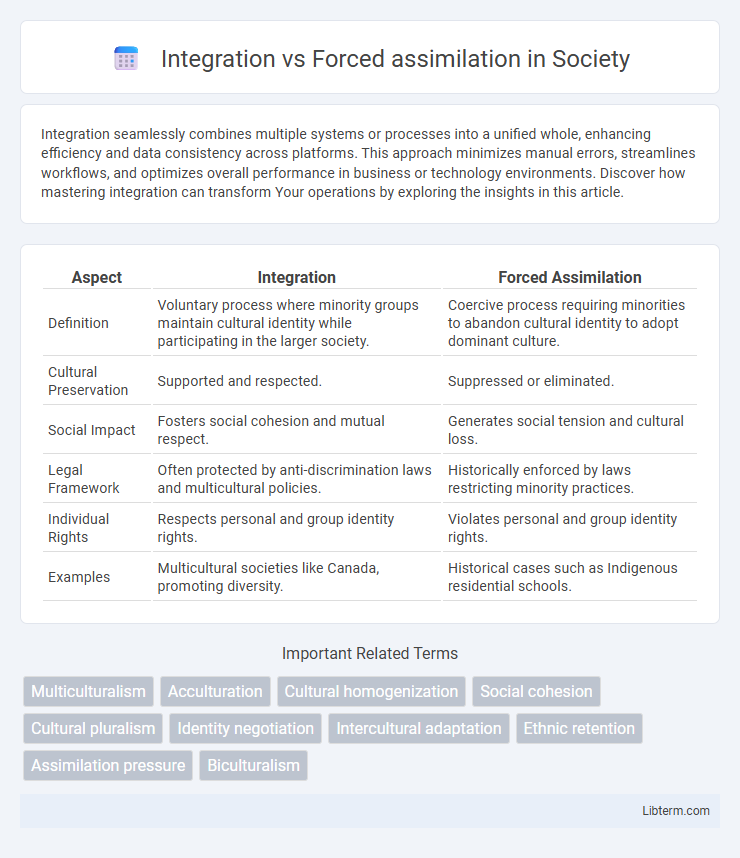Integration seamlessly combines multiple systems or processes into a unified whole, enhancing efficiency and data consistency across platforms. This approach minimizes manual errors, streamlines workflows, and optimizes overall performance in business or technology environments. Discover how mastering integration can transform Your operations by exploring the insights in this article.
Table of Comparison
| Aspect | Integration | Forced Assimilation |
|---|---|---|
| Definition | Voluntary process where minority groups maintain cultural identity while participating in the larger society. | Coercive process requiring minorities to abandon cultural identity to adopt dominant culture. |
| Cultural Preservation | Supported and respected. | Suppressed or eliminated. |
| Social Impact | Fosters social cohesion and mutual respect. | Generates social tension and cultural loss. |
| Legal Framework | Often protected by anti-discrimination laws and multicultural policies. | Historically enforced by laws restricting minority practices. |
| Individual Rights | Respects personal and group identity rights. | Violates personal and group identity rights. |
| Examples | Multicultural societies like Canada, promoting diversity. | Historical cases such as Indigenous residential schools. |
Understanding Integration and Forced Assimilation
Integration involves individuals or groups maintaining their unique cultural identities while participating fully in the broader society, promoting mutual respect and inclusion. Forced assimilation requires minority groups to abandon their cultural heritage and conform entirely to the dominant culture, often leading to loss of identity and social alienation. Understanding these concepts highlights the importance of respecting diversity and fostering environments where cultural differences coexist harmoniously.
Historical Contexts of Integration and Assimilation
Historical contexts of integration often involve intentional policies promoting cultural coexistence and equal participation within diverse societies, such as the post-apartheid South Africa reforms or the Civil Rights Movement in the United States. Forced assimilation, by contrast, has been characterized by compulsory cultural absorption through governmental impositions, including the Native American boarding school system in the 19th and 20th centuries and the Australian Stolen Generations policies. These contrasting approaches highlight the differing outcomes of voluntary inclusion versus coercive cultural erasure in shaping social cohesion and identity preservation.
Key Differences Between Integration and Forced Assimilation
Integration promotes coexistence by allowing individuals to maintain their cultural identity while participating fully in society, fostering mutual respect and inclusion. Forced assimilation mandates the abandonment of original cultural traits, often through coercive measures, leading to loss of heritage and social alienation. The key difference lies in voluntary cultural adaptation and preservation in integration versus compulsory cultural conformity in forced assimilation.
Social and Cultural Impacts
Integration fosters social cohesion by allowing diverse communities to retain cultural identities while participating fully in society, enhancing mutual respect and reducing social tensions. Forced assimilation often leads to cultural erosion, social alienation, and psychological trauma for minority groups, undermining community stability. Empirical studies show integrated societies experience higher social capital and cross-cultural collaboration compared to those enforcing assimilation policies.
Policy Approaches and Government Initiatives
Integration policies promote inclusive measures that respect cultural diversity while enabling minority groups to participate fully in society, often emphasizing language acquisition, equal access to education, and employment opportunities. Forced assimilation involves government initiatives aimed at eradicating distinct cultural identities through coercive practices such as mandatory attendance in state-run schools, suppression of native languages, and elimination of traditional customs. Comparative analysis reveals that integration fosters social cohesion and multiculturalism, whereas forced assimilation frequently results in cultural loss, social tension, and resistance from marginalized communities.
Case Studies: Successes and Failures
Case studies on integration versus forced assimilation reveal divergent outcomes across social and cultural contexts. Successful integration models, such as Canada's multicultural policy, demonstrate improved social cohesion and economic participation of immigrant communities by valuing cultural diversity and promoting inclusive policies. In contrast, forced assimilation efforts like the U.S. Native American boarding schools led to profound cultural loss, psychological trauma, and intergenerational challenges, illustrating the detrimental effects of coercive cultural conformity.
Human Rights Considerations
Integration respects individual cultural identities by promoting equal participation in society while upholding human rights, including freedom of expression and cultural preservation. Forced assimilation violates fundamental human rights by imposing dominant cultural norms and erasing minority identities, often leading to discrimination and social exclusion. International human rights law, including instruments like the Universal Declaration of Human Rights, emphasizes protection against such coercive practices, ensuring respect for diversity and dignity.
Challenges and Barriers to Integration
Integration faces challenges such as cultural differences, language barriers, and socio-economic disparities that hinder equal participation in society. Forced assimilation often creates psychological stress and loss of cultural identity, leading to resistance and social fragmentation. Both approaches confront systemic obstacles like discrimination, lack of access to education, and limited community support, impacting successful inclusion.
Long-term Outcomes for Minority Communities
Integration fosters sustainable social cohesion by allowing minority communities to maintain cultural identity while accessing equal opportunities in education, employment, and political participation. Forced assimilation often results in loss of cultural heritage, psychological distress, and social marginalization, leading to intergenerational trauma and decreased community resilience. Studies show integrated societies experience higher levels of minority empowerment, economic advancement, and reduced discrimination over time.
Toward Inclusive and Sustainable Societies
Integration fosters inclusive and sustainable societies by promoting equal participation and respect for cultural diversity, enabling social cohesion and economic development. Forced assimilation disrupts social harmony and undermines human rights by compelling minority groups to abandon their identities, leading to marginalization and long-term social instability. Policies prioritizing integration over assimilation enhance intercultural dialogue, reduce discrimination, and support durable community resilience.
Integration Infographic

 libterm.com
libterm.com